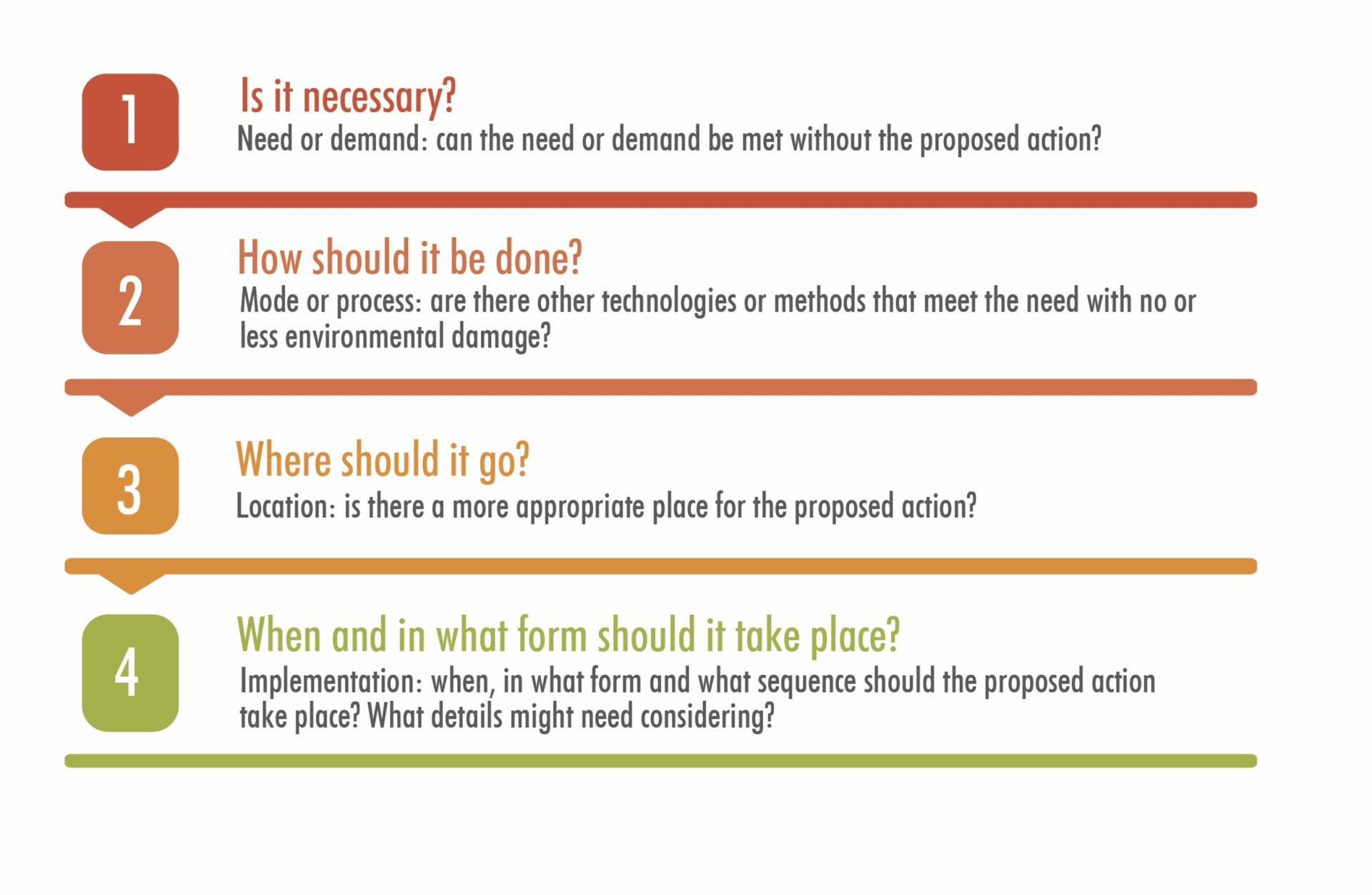The proposed action and alternatives
6.7.1 Understanding the proposed action
Although the proposed action is initially explored during screening (Section 6.4) and scoping (Section 6.5), much more detailed information is required for the impact assessment report. The amount of information should correspond to the scale and size of the proposed action. All stages of the proposed action’s life cycle should be considered (Figure 6.5) to understand exactly what will take place (directly and indirectly), how, and when. It is also important to understand if any associated facilities or infrastructure are needed to support the proposed action – for example, the creation of an access road or the installation of power lines – as these will also need to be assessed.

Figure 6.5. Stages in the life cycle of a proposed action. An impact assessment should consider the entire lifetime of a proposed action because impacts on Outstanding Universal Value might occur at any phase.
The precise location of all elements of the proposed action needs to be understood and mapped, in particular their relationship to the
World Heritage property
A cultural, natural or mixed heritage place inscribed on the World Heritage List and therefore considered to be of OUV for humanity. The responsibility for nominating a property to the World Heritage List falls upon the State(s) Party(ies) where it is located. The World Heritage Committee decides whether a property should be inscribed on the World Heritage List, taking into account the technical recommendations of the Advisory Bodies following rigorous evaluation processes.
When used as a general term, World Heritage refers to all the natural, cultural and mixed properties inscribed on the World Heritage List.
(e.g. within the property, within the buffer zone, upstream of the property, etc.), including all its components. Box 6.3 provides a checklist for the project description. It may be necessary to commission specialist additional documentation (e.g. a photomontage) in order to understand aspects of a proposed action which may affect the OUV.
Box 6.3
Proposed action
See: Action.
checklist
The information needed to understand a proposed action will vary, but normally includes the following:
● The need for the proposed action and its objectives
● The alternatives considered, including ‘no project’
● Description of the proposed action (including, if appropriate, how it will be built and operated)
● Location(s) and route of the proposed action (on a map)
● The type and duration of the proposed action
● Description of physical characteristics of the proposed action (for all phases of the life cycle)
● Layout and design of all project components (including drawings, visualizations, etc.)
● The nature and quantity of any natural resources that will be needed during all project phases
● Sources and amounts of residues, emissions, pollutants and other nuisances during all project phases
● Safety and security issues
● Access and required transportation
● Associated works, e.g. energy, waste, water infrastructure
● Other associated policies or projects and their geographical location
The area of influence for a project will change according to the nature of the proposed action and the environment in which it would take place. It might be the area which would be affected by the noise, dust or air pollution arising from construction, operation or closure of a proposed action, or it may be much larger (Figure 5.1). For instance, if the proposed action affects water levels in a river, the area of influence may extend to the entire watershed. The definition of the area of influence should be updated once impacts are identified and understood (Section 6.8).
6.7.2 Alternatives to the proposed action
Identifying alternatives to the proposed action at an early stage means that a full range of options can be considered while it is still possible to influence planning decisions, and even avoid negative impacts entirely by not proceeding with the proposed action. Exploring alternatives may also lead to the proposed action being revised or abandoned.
Alternatives can be considered in three steps:
- Identify reasonable alternatives. Various types of alternatives can be identified and explored, with those higher up the ‘alternatives hierarchy’ (Figure 6.6) generally providing more opportunities to be genuinely sustainable and reduce negative impacts. Strategic alternatives will typically focus on ‘why’ (Why is the action being proposed? Is ‘no project’ preferable?), ‘what’ (What action is needed?) and ‘where’ (Broadly where should the action be carried out?). More detailed project-level alternatives will typically focus on ‘where’ (Where precisely should the elements of the proposed action be located?) and ‘how’ (project management and timing). All alternatives should seek to avoid impacts on OUV, and be technically feasible and economically viable. Rights-holders Actors socially endowed with legal or customary rights with respect to heritage resources. In cases where there are Indigenous people involved, they have the right to free, prior and informed consent before approval of any project affecting their lands or territories and other resources, and need to participate in impact assessment. , local communities and other stakeholders, including environmental and heritage authorities, should be consulted at this stage, as they may suggest alternatives that the proponent would otherwise not have considered. Where alternatives are not reasonable (e.g. for technical or financial reasons), these can be eliminated early on, but for transparency this should be documented, with an explanation as to why they have been eliminated.
- Assess and compare alternatives. The impacts of reasonable alternatives should be assessed and compared using the same techniques and degree of rigour as the assessment of the proposed action (see Section 6.8).
- Explain the choice of preferred alternative. A clear reason should be provided for the choice of the preferred alternative, which should include its environmental, social and economic sustainability, as well as its cost, technical feasibility, local acceptability etc.

Figure 6.6. The ‘alternatives hierarchy’. The higher-level alternatives generally have more potential for reducing negative impacts and promoting sustainability.



